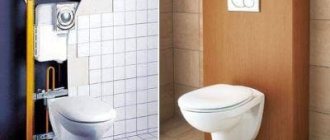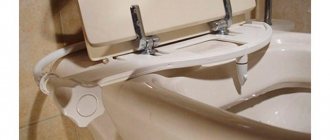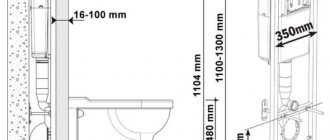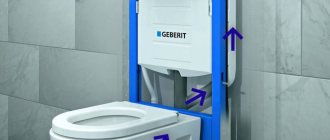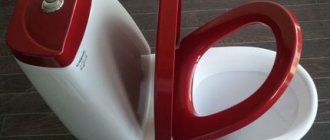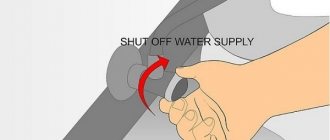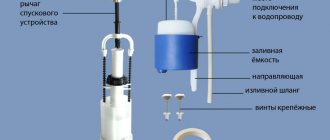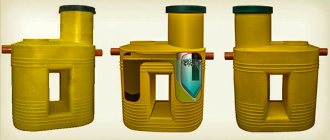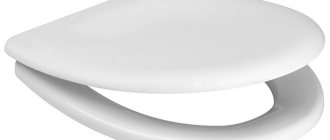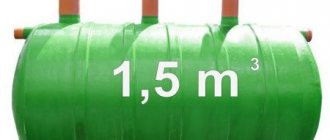Advantages of vertical release
Toilet with vertical outlet
There are three types of drain location:
- horizontal;
- oblique;
- vertical.
In Russian apartment buildings, openings are provided at right or narrow angles of up to 30 degrees.
A toilet with direct outlet to the floor is installed in cottages, townhouses, luxury new buildings or old large houses of the Stalinist layout.
Floor structures are reliable, durable, easy to install and maintain. The sewer outlet directly down has many advantages:
- saving space in the bathroom;
- the ability to create a unique design project;
- minimum blockages;
- no leaks;
- ability of non-standard planning.
A toilet with a vertical outlet can be mounted close to the wall, unlike horizontal and oblique outlets, which require a distance of 3-10 centimeters.
When creating your own bathroom project from scratch, the sewer hole can even be located in the middle of the room. When choosing a model, make sure that the outlet diameter of the toilet matches the size of the floor drain.
Installation methods
The installation consists of 2 stages - actually installing the housing and attaching it to the floor, as well as connecting it to the riser. And if there shouldn’t be any special issues with fixing it to the floor, then with connecting a plumbing fixture there are several options, but in any case, all the work can be done with your own hands.
Using sewer corrugation
A special sewer corrugation allows you to connect even when there is not enough free space. Externally, the corrugation looks like a ribbed stretchable plastic pipe; it can be used to connect a toilet with both a straight and an oblique outlet.
Flexible sewer corrugation
Installation of a plumbing fixture is carried out in the following sequence:
- first, pretend to place it in the restroom, mark the position of the hole in the floor for fastenings;
- then the plumbing fixture is put in place and dowels are inserted into the floor into the drilled holes;
- then the corrugation is put on the toilet outlet, in this case it is necessary that the corrugation moves approximately 5-6 cm;
It can be seen that the corrugation is pushed all the way
Note! When connecting a toilet with direct outlet (and with other types of drainage), special attention must be paid to the tightness of the connections. When using corrugation, it is advisable to use silicone sealant; this will definitely not cause any harm.
- After this, you can insert the second end of the corrugation into the pipe; the same sealant is used to seal the connection. The connection is now considered complete; the last thing left to do is to connect the drain tank.
Installation steps
Note! The sealant must be located between the surfaces of the corrugation and the outlet. If you try to coat the joint with it after the connection, there will be no benefit.
The last thing left to do is to check the tightness of the joints. To do this, it is enough to pour a bucket of water into the toilet and observe the joints to see if they are leaking and finally install the plumbing fixture on the tile with the obligatory sealing of the installation site with sealant.
Connecting models with oblique outlet without corrugation
Let's find out when choosing a specific toilet - it is not always possible to choose an oblique outlet or a straight one, because you have to adapt to the already existing sewerage distribution in the apartment. Sometimes you have to settle on models with an oblique drain.
If the axes of the outlet and the sewer pipe are in the same plane or are not very displaced relative to each other, then you can do without a rather fragile corrugation. In this case, to connect the plumbing fixture you will need a plastic adapter and a rubber cuff (optional); an adapter for a toilet with direct outlet is used for the same purpose.
Everything you need for installation
The main task during installation is to ensure that the plumbing fixture is located as close as possible to the back wall of the restroom. Of course this shouldn't affect the flow. Ideally, the outlet from the plumbing fixture is connected directly to the tee on the riser.
The connection itself is quite simple - using an adapter, the toilet outlet is simply connected to the sewer pipe, and the joints are sealed. If the holes are offset relative to each other, then an eccentric rubber collar can be used.
The photo shows an eccentric cuff
Note! It is undesirable to stretch the corrugated pipe too much; its wall is quite thin and can easily tear. Its price is not that high, so it’s better not to skimp on the length.
As for tightness, it is achieved in the following way:
- a solution is prepared from red lead and drying oil, and the toilet outlet is coated with it;
- tarred tow is wound on top; after winding, the tow is additionally soaked in the prepared mixture;
Note! The edge of the outlet (1-2 cm) should be free from winding so that nothing interferes with the flow of water.
- then the adapter socket is simply put on the outlet or the outlet is inserted into the sewer pipe socket.
A picture familiar to many
Not everyone has lead and drying oil on hand, so you can do without the above steps and simply use rubber cuffs and sealant to ensure tightness.
Do-it-yourself direct flush toilet installation is considered the easiest. To do this, you only need an adapter, sealant and a rubber seal. To connect, just connect the outlet and the tee on the riser with an adapter. Instead of a plastic adapter, you can get by with a corrugated one.
Toilet with vertical outlet
In this case, the drain is performed into a pipe located in the floor. In this case, a corrugated pipe and adapters will not be needed - the outlet will connect directly to the sewer pipe.
Initial stage of work
If the installation of a toilet with a direct outlet involves the use of adapters or a corrugated pipe, then to connect a plumbing fixture with a vertical flush you only need a screw flange.
The work is performed in the following sequence:
- a screw flange equipped with a lock is installed on the pipe in the floor;
Flange installed
- after this, the base is prepared - holes for fastenings are drilled;
- The toilet is installed on the floor, and its outlet is inserted into the flange and is pressed very tightly against the pipe. Additional sealing is provided by a rubber ring and sealant.
Popular lines
Design of the brand “Sanita”
Plumbing stores offer models from Russian, Italian, German, and Czech manufacturers in the range of 2,000–150,000 rubles. The price is determined by the brand rating, design features and material of manufacture.
The budget line, costing from 2 to 10 thousand rubles, is represented by faience toilets “Sanita” and “Iddis”, “JIKA”, “Roca”, “Ifo” “Gustavsberg”. The basic design of units with floor inlet is equipped with the necessary installation kit. The products are made in a standard design: a rectangular bowl and tank.
Elite samples of sanitary ware are produced by European, Finnish “Ido”, Swiss “Laufen”. The price threshold is from 20,000 to 150,000 rubles. The toilets are made in an original design with bizarre shapes of the constituent elements.
Expensive models with vertical output are made of porcelain, clay and stainless steel. The material is coated with an antibacterial and dirt-repellent layer. The design can be equipped with a control panel, liquid for disinfecting nozzles and a hair dryer for drying.
Comparison of popular models
Customer reviews will help make choosing a compact toilet with a vertical outlet easier. In every price range there are the most popular items.
Comparison table of popular toilets:
| Model | price, rub. | Housing material | Size, cm (Width x Length x Height) | Advantages |
| Santek Animo 1WH302133 | 3990 – 6120 | faience | 38x63x78 | economical drain; antibacterial spraying; spacious tank 6 l. |
| Jika Mio 823716000 | 13609 ‑ 24491 | porcelain | 36×69,5×81 | double drain mode; Duroplast seat with soft closing function (SoftClose); antibacterial surface treatment; chrome hinges. |
| Sanita luxe Next | 3900 ‑ 9300 | porcelain | 34.5x63x75.5 | economical water drainage mode; anti-splash function; antibacterial coating; seat cover with microlift. |
| Gustavsberg Nautic 5510 | 16105 ‑ 19284 | porcelain | 34.5x86x85 | saving water consumption; “Anti-splash” guarantee has been increased to 25 years. |
| Laguraty OK 0002A | 22400 ‑ 32600 | 37x72x89 | original design: egg-shaped bowl; double flush; anti-splash system; antibacterial coating; Quiet collection and drainage of water. |
Premium models are distinguished by a stylish design and a maximum warranty period for the performance of all elements of the product: from the tank and bowl to the hinges and mechanisms.
Budget options are attractive in price and differ little in functionality.
Classification of toilets
We have already found out that toilets differ from each other in many ways. It turns out that the bowl itself can influence the efficiency of work. We have already looked at bowls with a shelf and a vertical drain. In Russian toilets, the neck is most often located closer to the front edge of the toilet, although there are models with a different location.
This is provided in any case, because the neck cannot go directly into the drain, otherwise all gases from the sewer will in this case pass into the room. To prevent this, every toilet has a siphon, or otherwise called a water lock. It looks like a curved tube, it definitely contains water.
Some people are mistaken in believing that the more vertical the drain is, the closer to the wall the device should be placed. But this cannot always be done, because toilets are divided into:
- Direct toilet flush;
- Oblique;
- Vertical.
You don't have to choose a drain, because you need to buy a toilet with an outlet that fits your sewer system. If you are building a house with your own hands, you can first decide on the choice of toilet, and then install a sewer system for it.
The most versatile is the oblique projection; if desired, it can be connected to any outlet of the sewer pipe. Direct drainage is suitable for you if the pipe neck is located at a certain height from the floor. A location below the floor may be suitable for a vertical drain.
Criterias of choice
When purchasing a piece of bathroom furniture for long-term use, you should consider several features.
The significant parameters are:
- size;
- material;
- form;
- mechanism;
- type of bowl.
The area of the bathroom will determine the dimensions of the toilet. If you have a spacious sanitary room, you don’t have to think about it and purchase a unit with any parameters. For a compact toilet, a small toilet is suitable in order to save scarce space.
Pay attention to the material from which the product is made. Earthenware will cost less, but it will need to be cleaned more often. Porcelain and ceramic toilets are more expensive, but have an increased service life and a dirt-repellent coating, which will make them much easier to use.
When choosing a shape, you should take into account the design of the bathroom. Rectangular products will fit better into strict minimalism and classic interiors. Rounded outlines are suitable for non-standard solutions and will help to visually increase the space of the room.
There are expensive models of toilets with automatic flushing. Touchless flushing does not require user intervention. However, the system requires professional repair if it breaks down. Mechanical options that require pressing a button are more common. They are simple and reliable. The presence of a double flush allows you to use the volume of water in the tank by half or completely, which ensures savings in consumption.
The bowl determines the type of water discharge and the amount of splash after flushing. This element can be dish-shaped, funnel-shaped or visor-shaped. The most successful option is the last one. In this case, the vertical flush of the toilet is carried out in a circle, cleaning the bowl and taking the splashes with it.
An important detail is to check the availability of components for installing fasteners, hinges and gaskets.
Thus, it is better to choose a model of small size and streamlined shape made of porcelain with a visor bowl and a circular type of mechanical drain.
The ideal vertical toilet - what will it be like?
The question of choosing perfection is quite complex. It is impossible to give exact instructions for everyone, since the selection largely remains individual. There are general rules that help bring a bathroom closer to the ideal without affecting design and dimensional features:
- High quality parts. Such models are a little more expensive, but will save owners from constant breakdowns and the need for preventive maintenance.
- A circular type drain copes more effectively with contaminants.
- Mirror with “Auto splash” system protects against splashes and keeps clean.
- Experts still recommend leaning towards porcelain, as it is more durable, cleaner, and looks more expensive.
Installation of a toilet with vertical outlet
Toilet installation
To connect a new unit you will need a minimum set of tools:
- perforator;
- screwdrivers;
- spanners.
Additionally, it is necessary to use plumber's hair and sealant.
Installation procedure:
- Place the toilet in the future mounting location and outline the lower perimeter with a felt-tip pen on the floor.
- Take the flange from the unit packaging and attach the fixing anchors to it.
- Lubricate the flange on the floor side with sealant and screw it onto the sewer hole using a hammer drill.
- Install the unit on the protruding bolts, securing with sealant and plumber's hair.
- Connect the water and check the tank is filled and drained.
Care must be taken when installing fragile and slippery toilet items. To prevent leaks, it is better to wrap all connecting elements with plumber's hair and lubricate them with sealant. A correctly mounted structure should not deviate or move to the sides.
